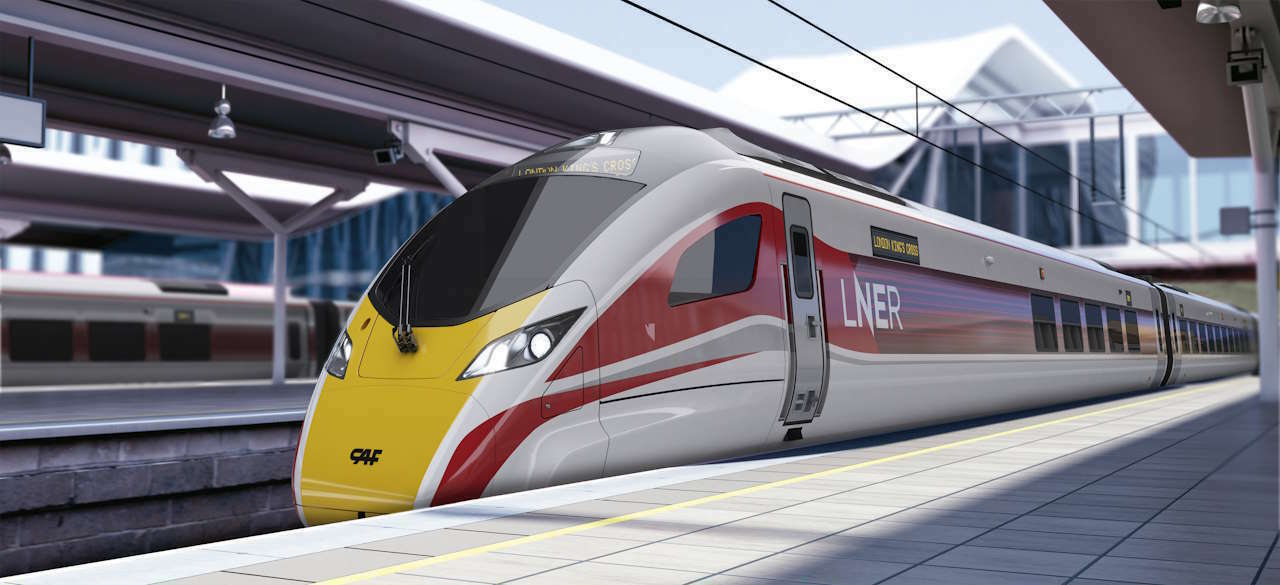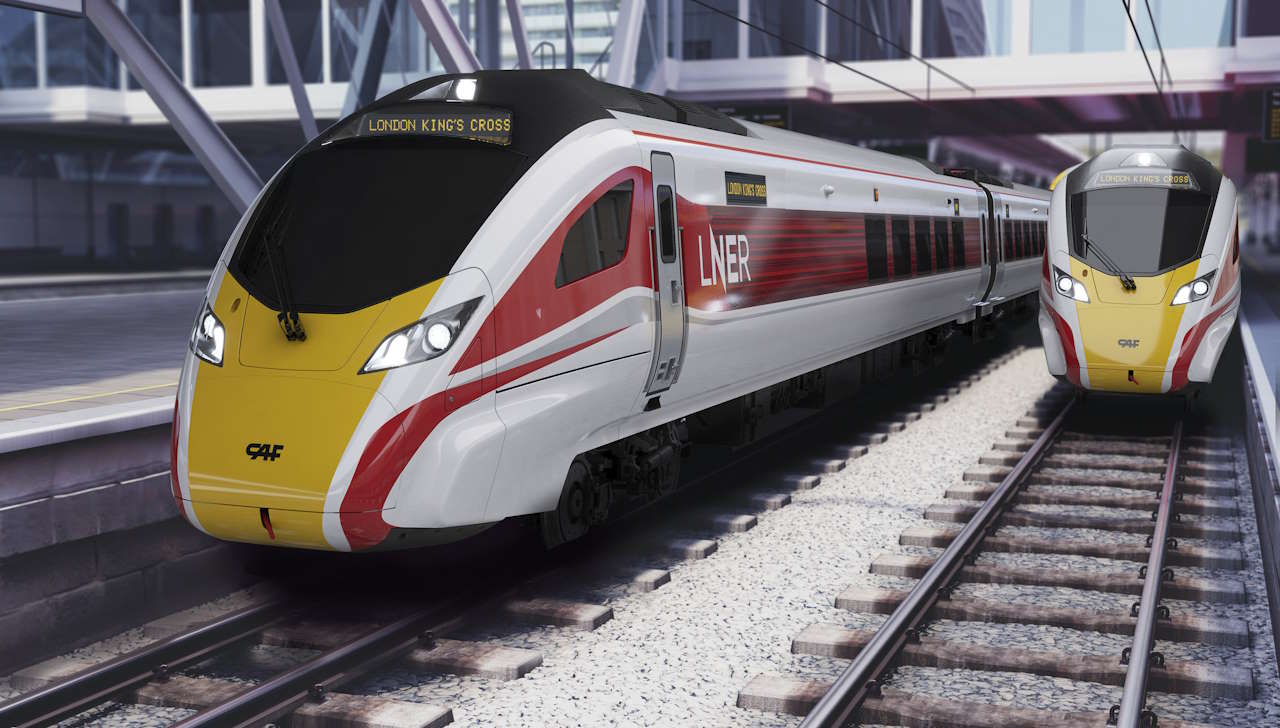London North Eastern Railway has announced it has ordered 10 new Tri-Mode trains from train manufacturer, CAF.
Porterbrook will finance the new fleet of trains, which will be able to operate in electric, battery or diesel mode.
The new fleet of trains will complement the existing LNER Azuma fleet.
Battery power will allow the trains to operate where overhead power lines are not available without using the diesel engine.

David Horne, Managing Director at LNER, said: “Successfully delivering this new fleet is an integral part of LNER’s Business Plan. Our focus is ensuring we create a fleet that truly matches the needs of all our
customers, with clear targets on setting new standards for comfort, accessibility, and exceptional
customer service.
Rail Minister, Huw Merriman, said: “Replacing ageing rolling stock is crucial to the sustainability,
reliability and growth of our rail network, and I’m delighted passengers travelling on LNER services will benefit from improved services and greener journeys on these modern trains.
“Private sector investment plays an important role within the UK rail industry and this order will help
drive economic growth across the country while supporting skilled jobs.”
Richard Garner, CAF UK Director, said: “The new CAF fleet of more sustainable and environmentally
friendly tri-mode trains will reduce carbon emissions, noise and vibration pollution and optimise energy consumption while increasing service operation efficiency and performance on the East Coast Main
Line.”
Mary Grant, Porterbrook CEO, said: “Porterbrook is delighted to fund and take ownership of this state-of-the-art new tri-mode fleet for LNER, supporting its focus on creating a world-class service that matches the needs of customers with lower emission trains.”





Responses
This is my first comment on this forum, so please be gentle with me.
I’m disappointed at all the negative comments about this order.
Maybe Hitachi couldn’t deliver what LNER want to achieve.
There is no timescale for when these trains will enter service, comments about the power supply and accomodation arrangements are premature.
The weight of any battery banks may be offset by them replacing some of the diesel engines. GWR, I believe, are testing this on at least one IET 802.
Using battery or diesel power in areas of outstanding natural beauty would replace intrusive OHLE. How much damage to the environment is caused by the tonnes of steel for gantries and wires.
I’ll end my spouting now.
One day, someone somewhere will realise that complex bimode trains are going to cost a lot more overall than finishing the job of electrification. That can has been kicked down the road time and again. The result is lots of diesel miles under wires on cross-country routes especially, but also in places like the incomplete GWR, which doesn’t even allow trains to run from Bristol to the maintenance depot under electric power.
It’s an interesting mix of technology .. When on Diesel burning fuel to carry a load of batteries around. Then when on battery, battery power being used to carry the weight of diesel engines and fuel around. And when on battery or diesel using energy to carry around a 25kv transformer !!! .. Clearly this has been fully thought through by the “experts” !!!
The Government Baden Württemberg study has shown that hydrogen and bi-modes are up to 80% more expensive than fully electric trains on most routes. Will the Lumos remain the only fully electric trains on the ECML for the foreseeable future. Who benefits from the compromise solution – the Banks who own the ROSCO’s?
This is madness. Why would LNER management want to make their life more complicated by ordering a non-standard train design? What is wrong with the existing Hitachi Class 80x design?
Haven’t they been following the slow motion disaster at TPE? Also, these so-called tri-mode trains are going to drag around both heavy batteries and diesel engines. How much energy is that going to waste? Can’t LNER get off the fence and choose one or the other?
CAF have donated £150,000 to the Conservative Party over the past 6 years or so. I’d assume that unfortunately has a lot to do with it given that LNER are 100% DoT owned.
Has anybody mentioned speed? 125? Nova 2 is ok I trust these will be similar?
Azuma aren’t a real intercity train, it’s a commuter train beset by issues and generally has a rough ride, poor seating , poor luggage capacity, the toilets keep breaking and the wheels etc need welding. Essentially the Azuma is rubbish.
I couldn’t agree more! Compared with a Mk4 set the ride and noise levels are dreadful – and those were inferior to the HSTs.
Train wheels are not welded, they are a mono block wheel, wheels are machined when required and once down to a wear line they are re wheeled
So much for the evonomies of fleet standardisation.
As has already been demonstrated by TPE with three different fleets in the Nova service.
No doubt this will mean the demise of the Intercity 225 trains. Although around 30 years in service, the Intercity 225 trains are far more comfortable, quieter and more smooth running than the Azumas. I find, notably, that the Azumas give a very rough ride in two places, one close to Peterborough and one close to Grantham. If it was my choice, I’d scrap the Azumas and build more Intercity225 sets.. updated.
I just hope they fit more comfortable seats than those on the Azumas.
Hopefully yes Colin, issues around Azuma were fact they were ordered when East Coast route was last in public ownership of East Coast trains all design spec from that time. When route was privitisation again virgin and subsequently back into public hands as lner who now stuck with trains they did not have say in design inc seating only thing lner allowed was branding and say on kitchens
The new CAF trains I’d imagine lner have free rein specify exactly what they want from fleet.
Are we so unskilled as a country that we now have to buy trains from Spain rather than manufacture them ourselves?
These trains will be built in Wales at CAF’s assembly plant in Newport.
Assembly and build are not the same thing…
The terms are frequently used interchangably as obsfucation by the Government and companies to give the impression something is British made when it’s not…
It’s kind of like the difference between a Michelin star’d chef’s hand preparation of a 3 course meal and the part time dish washer microwaving a ready meal then claiming ‘freshly made in our kitchens’…
But suffice to say Jonathan is correct, most of the skills and capability we had to design and build a top of the line IET type train no longer exist in the UK.
Why on earth would LNER want to order more new trains just because they already got the Class 800 and Class 801 Azumas that are still new and of course the Class 91 Mk4 are to be phased out as they are getting old. And some of the Mk4+DVTs have been transferred to TfW.
You said it yourself Andrew. The CAF trains are to replace the remaining InterCity 225 sets (which were retained for additional capacity).
The class 91’s may be retiring soon by the looks of it, regardless, these new trains may look smooth and sleek yet they could be uncomfortable inside. I’d take an intercity 225 set over one of these new CAF trains any day of the week.
One has to wonder why these weren’t ordered alongside the rest of the IET Programme. Surely there’s a benefit to operating fewer different classes of train, and the Class 800 family is supposed to have modular power equipment to enable battery power.
New trains for LNER to replace the Class 91 rolling stocks that are currently being used. I wonder if LNER will expand more of their services including to Scarborough, Hartlepool and Whitby from next year.
Similar to the TransPennine Express Class 397 Nova 2. And to replace the Class 91 Mk4 coaches.
I guarantee you that the new LNER tri-mode trains will be classified as in the Class 39x category.
Class 391?
Class 392?
Class 393?
Class 394?
Class 396?
It’s a bit hard to see LNER extending their services to Whitby!
Or what about in the Class 7xx or Class 8xx.
When you have a fleet all of one type why on earth would you decide to add a very small fleet of another.
Not only do have to train crews on new traction but there will be extra cost in the maintenance departments different spares
Is the intention to run them on a specific route?